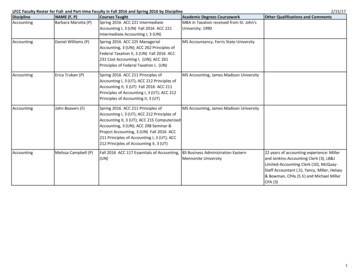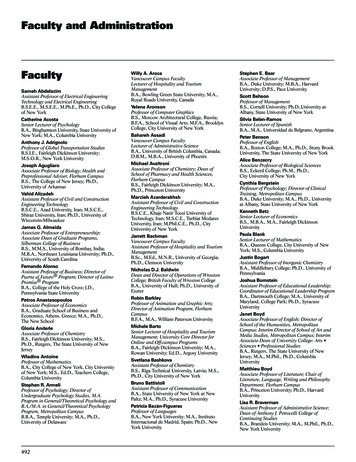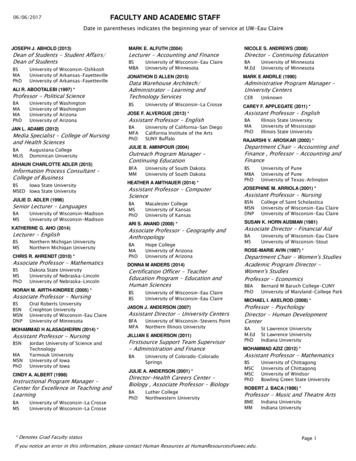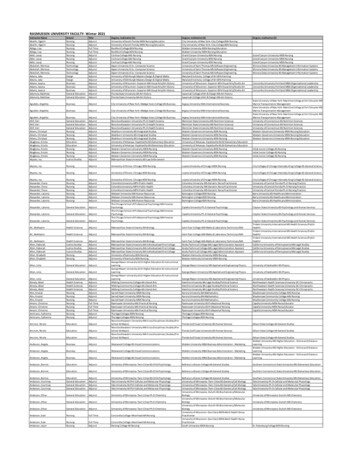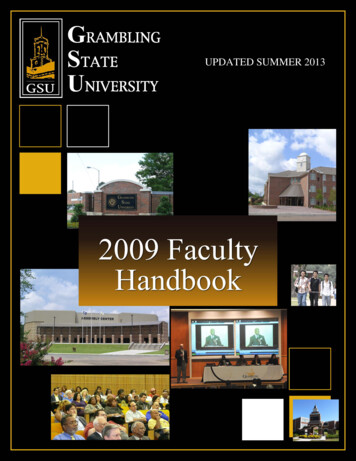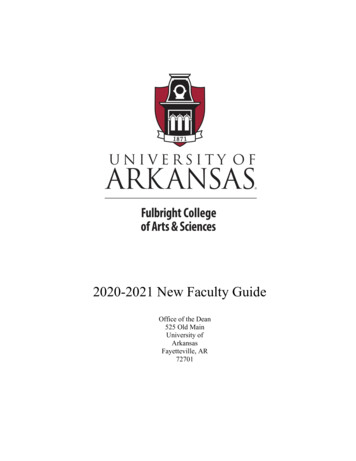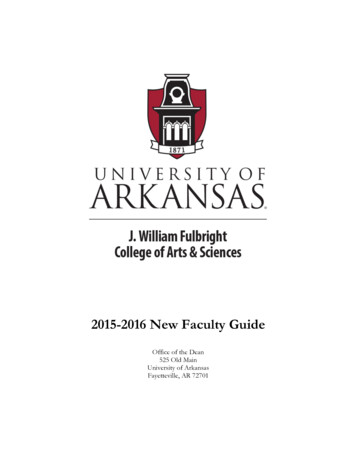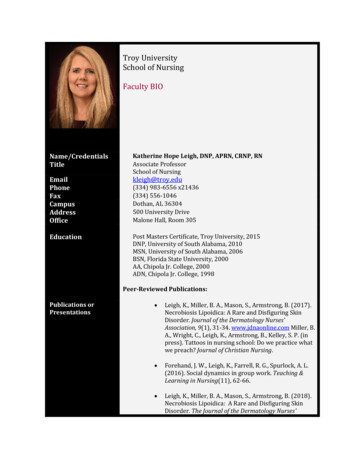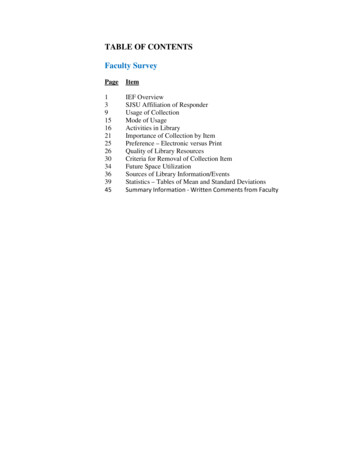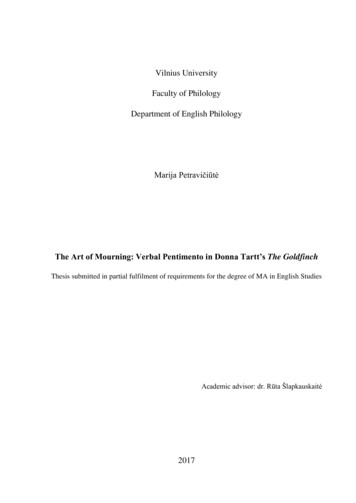
Transcription
Vilnius UniversityFaculty of PhilologyDepartment of English PhilologyMarija PetravičiūtėThe Art of Mourning: Verbal Pentimento in Donna Tartt’s The GoldfinchThesis submitted in partial fulfilment of requirements for the degree of MA in English StudiesAcademic advisor: dr. Rūta Šlapkauskaitė2017
Contents:Abstract . 31. Introduction . 42. The Matter of Matter: A Theoretical Frame . 113. The Denial of Death: Art and the Illusion of Presence . 204. Conclusions . 36Summary in Lithuanian . 37References . 38Appendix . 402
AbstractThe present MA paper aims to examine Donna Tartt’s The Goldfinch (2013), a novel which isprimarily preoccupied with the themes of art and death. Seeing as one of the purposes of thisthesis is to establish relevant connections between the logic of still life paintings, theprotagonist’s life choices and, consequently, his way of constructing the narrative, theanalysis of this novel is based primarily on Norman Bryson’s examinations of still lifepaintings and Hans Belting’s anthropological observations about the connections between theconcepts of art and death. Furthermore, an examination of the narrative relevance of 17thcentury Dutch paintings and the way these works by Carel Fabritius, Frans Hals, andRembrandt Harmensz. van Rijn foreshadow certain plot twists will also be presented in theanalysis part. Seeing as the novel addresses the relationship between the verbal and the visual,the analysis will also be based on Liliane Louvel and her notion of the iconotext and thetypology of pictorial saturation. By employing Louvel’s terminology, I will argue that thevisually saturated verbal descriptions of Theo’s romantic interest Pippa in fact reveals hisobsession and even objectification of the female character.3
Caring too much for objects can destroy you.Only – if you care for a thing enough,it takes on a life of its own, doesn’t it?And isn’t the whole point of things – beautiful things –that they connect you to some larger beauty?Donna Tartt, The Goldfinch1. IntroductionThe quote from American author Donna Tartt’s latest novel and the object of this MA thesisdraws the reader’s attention towards an undeniable truth that we live in the world of things.Whether we are always fully aware of it or not, we are surrounded by material objects that weourselves make, use, and invest with meaning. The use of things is based not only onnecessity; the kinds of things we surround ourselves with, the memories and experiences weattach to them and the ways we treat them can provide useful insights into our culture and thesocial relations among people that are often governed by relations with things. Thedevelopment of these special relations to inanimate objects already has its roots in earlychildhood, an illustration of which is “The Philosophy of Toys” (1853), an essay by Frenchpoet Charles Baudelaire in which he discusses children’s ‘overriding desire’ to destroy theirtoys in order to get to their souls (Baudelaire in Mayne 1964: 203). However, when a childbreaks his toys, he obviously does not find their souls and is consequently left with feelings ofmelancholy and gloom. Although it seems that we deal here only with the power of children’simagination, this example nevertheless suggests a certain attitude towards inanimate objectsand the belief that they can, as Tartt writes, take on lives of their own. Not surprisinglyBaudelaire himself saw a child’s relationship with his toy as an analogy of the relationshipbetween an adult and a work of art (ibid., p. 201). Although one cannot deny that any artworkis a manmade thing, there is still that sense that there is some hidden significance in the thingitself.Regardless of the nature of an object in question, whether it is a work of art or a mundanething, that particular item cannot shed its ‘thingly’ quality, which means that it is part ofmaterial culture. In order to study material culture one requires knowledge from a range ofdifferent disciplines, including history, anthropology, sociology, etc. Thus, it is not surprisingthat arts and literature explore this issue as well. The significance of material culture is closely4
tied to the mid-18th century, which marked the beginning of the Industrial Revolution, theperiod considered to minimised the distinction between luxury and necessity (Bryson 1990:97). In England, people who probably valued luxury items to the fullest were the Victorians.In Portable Property: Victorian Culture on the Move (2008) literary scholar John Plotzfocuses on English literature produced during the period between 1830 and 1870 and notesthat those forty years were marked with an ‘obsession with objects represented asproblematically endowed with sentimental and fiscal value simultaneously’ (2008: 7). TheVictorians were fascinated with objects, whether it was a piece of jewellery, a piece ofclothing, a toy or a piece of furniture, they all constituted part of their identities. As the title ofPlotz’s work suggests, this attachment to material things was especially felt during travels, orin other words, on the move. When one becomes detached from familiar places and people,certain things transform from merely material objects to sentimental possessions endowedwith memories and experiences (ibid., p. xv). It is not surprising, then, that portable propertygained such significance in the Victorian era, during the Imperial expansion. Plotz argues thatsuch attachment and identification with one’s possessions can be explained by tracing a shiftin the meanings attributed to the words ‘portable’ and ‘portability’. The scholar notes thataround the 1830’s novelists began to use objects in English literature in ways which were newat the time. The words ‘portable’ and ‘portability’ acquired looser meanings and began to beused not only literally, but metaphorically as well. Plotz argues that precisely this duality ofmeaning attributed to portable property is one of the defining aspects of Victorian literature(ibid., p. 4). While providing illustrations from the works by novelists George Eliot, RichardDoddridge Blackmore, Frances Hodgson Burnett, Thomas Hardy and others, the scholarsuggests reading ‘Victorian novels as a series of works about portable property that were alsomeditations on their own status as pieces of portable property’ (ibid., p. xv). However, it isstriking that one of the most convincing illustrations of the duality of meaning of portableproperty in Plotz’s work comes from non-fiction, namely Harriet Tytler’s story recorded inher memoirs written in India. Plotz argues that English strawberries were the objects thathelped her identify as an English woman: ‘[b]orn in what she cannot conceive as her ownland, raised to idolize an England known only through words, pictures, and stories, Tytlercannot resist the chance literally to ingest England’ (ibid., p. 45). English strawberries,therefore, is portable property both literally and metaphorically. They were once brought toIndia and planted there, which suggests their portability in the literal sense. For Tytler,however, they also became the carriers of stories and memories of the distant homeland, ofeverything that was English.5
Of course the Victorians were not the only ones charmed by objects. The same phenomenonwhich spread in the 19th century is evident in the French literature of this period. In her workLiterature and Material Culture from Balzac to Proust: The Collection and Consumption ofCuriosities (1999) Janell Watson addresses the issues of collecting and consuming curiosities,or to use the modern French word, bibelots. Watson argues that the use of the bibelot quicklyincreased in French literary works by Honoré de Balzac, the Goncourt brothers, StephaneMallarmé, Guy de Maupassant, Gustave Flaubert, Émile Zola, and Marcel Proust, whichsignified a change in the way people viewed material objects. They were no longer mereinformants about the habits of their users; more and more narrative space was given to theobjects themselves. The scholar acknowledges that although she works primarily in thecontext of 19th century French literature, the interest in material goods is evident in the worksproduced in other European countries, North America, and many former European colonies(Watson 2004: 1). Watson suggests that the use of the bibelot, an object without use-value,increased in French literary texts of the above mentioned authors because the bibelot startedto appear in the home interiors of the 19th century and this phenomenon was thereforerecorded by the artists of that time. For Balzac, for example, ‘the objects of decor are relatedto sociology (.), to scenes of seduction (.), or to the collector’s passion (.) rather than tothe splenetic disposition of the aesthete’ (ibid., p. 68). Thus, it seems that bibelots in Balzac’sdescriptions of interiors were used in order to reflect the inner world of their owners. Proust,who is on the other end of the long list of French authors Watson deals with, ‘announces theend of the Balzacian-style interior (.). Proust does not give up describing interiors, however,though he must learn to do so differently’ (ibid., p. 148). Watson argues that the Balzacianinterior reflects the status of its inhabitants; their class, profession, tastes and other personaldetails can be decoded by paying attention to the furnishings of their homes (ibid., p. 150). InProust’s case, objects are no longer meaningful in the sense that they do not provideinformation about their owners: ‘[t]hese historic, artistic, and literary interiors are inhabitedby non-historians, by non-readers, and by non-art lovers (.). The furnishings and bibelots ofthe 1890s have become what Baudrillard might call empty signifiers, signifying fashion itself’(ibid., p. 152). Thus, it seems that at the beginning of the 19th century, as in the case ofBalzac, people were privileged over objects; things were valued for their usefulness and theywere used in literature to provide information about their owners. Over the course of time,however, the distinction between what is useful and useless became less obvious and theobjects gained more significance of their own, thus limiting the gap between people andthings.6
Outside Europe, one of the seminal critical works dealing with object-oriented fascination inliterature is A Sense of Things: The Object Matter of American Literature (2003) by BillBrown, a leading scholar in the field of American culture, who is known for hisconceptualisation of Thing Theory, which was developed on the grounds of Germanphilosopher Martin Heidegger’s work. A Sense of Things: The Object Matter of AmericanLiterature is Brown’s critical exploration of the roots of passion for material culture inmodern American literature. He refers to the works of such writers as Mark Twain, FrankNorris, and Henry James and tries to explain the significance of things in their novels.Similarly to Plotz and Watson, Brown argues that thinking about things strictly in terms ofconsumerism is an over-simplification and he tries to show how people’s relations with thingscannot be explained only according to the logic of capitalism, which was the idea advocatedby Marxism (2003: 5). More than anything else Brown is interested in the way objects infiction become subjectified and subjects become objectified, he tries to understand howobjects are used to make sense of the world and of oneself, and how certain of our wishes anddreams, fears and anxieties are projected onto or expressed through objects. At the heart ofthis lies the dichotomy between ‘having’ and ‘being’, between owning a material object andidentifying oneself or someone else with it (ibid., p. 13). One of the ways in which a characterindentifies with the objects he is surrounded by on a daily basis is introduced in the secondchapter of Brown’s book titled “The Nature of Things”. By providing examples from Norris’snovel Vandover and the Brute (1914), Brown puts forward the idea that our relations withthings are based on habits:Our habitual interactions with objects both bring them to life and impose order onthat life; our habits both mark time and allow us to escape from time, as weperform the present in concert with the future and the past. By doing the samething with the same things you create the illusion of sameness and continuity overand against the facts of disorder and change. (2003: 64)Repetition, thus, plays an extremely important role not only in the transformation from merelymaterial objects to priceless possessions, but also to substitutes of the self. One might becomeso attached to certain things that their loss could result in an existential crisis (ibid., p. 65), anidea which also finds its place in Tartt’s novel as conveyed in the extract quoted in theepigraph: ‘caring too much for objects can destroy you’ (Tartt 2014: 848). What fascinates memost in Brown’s work, however, is not the analysis of the relationships between charactersand their possessions in various works of American literature, even though this study isextremely thorough, but the quite simple and yet at the same time intriguing view that a bookitself, in being a piece of literature, is also a material thing with ideas in it (Brown 2003: 911).7
This is how I read Donna Tartt’s novel The Goldfinch (2013): both as a work of art and as amaterial object that I can carry with me and that carries within itself a variety of intertextualreferences ranging from a tribute to Charles Dickens and realist literature to associations withHarry Potter, embracing classical music and the likes of Lady Gaga, and championing 17 thcentury Dutch painting as well as American modernism. Seen in this light, it may not besurprising that Tartt, a contemporary American writer, who received critical acclaim for herfirst two novels, The Secret History (1992) and The Little Friend (2002), in 2014 wasawarded the Pulitzer Prize for Fiction for The Goldfinch, a story about Theodor Decker, athirteen-year-old boy, who survives an explosion at the Metropolitan Museum of Art in NewYork during which his mother dies. Theo manages to escape from the museum unnoticedcarrying two precious possessions, a Dutch masterwork called “The Goldfinch” and a ring,given to him by a mysterious old man. The tragic loss of his mother sets his fate to wonder offwithout a permanent place in life. After staying with a family of his wealthy friend, Theo istemporarily taken in by his drunken father and his girlfriend in Las Vegas, later on is forced togo back to New York to a generous and caring owner of an antiques shop, and finally evenends up with a criminal underground world in Amsterdam. In the whirlpool of all this tormentTheo clings to the small painting of a goldfinch which reminds him of his mother and,therefore, is valued by Theo not as a priceless work of art, but as the only thing linking hispast and future. By giving so much narrative space to this missing link, the famous paintingaround which the story revolves, Tartt raises the issue of value. Is this painting, and art ingeneral, valuable for its technique and the artist’s reputation or for something very individualand subjective for each of us? And, in the latter case, is there a difference then between a wellknown-work of art and a mundane thing?The question of value, which is articulated through the narrative’s intertextual references tonumerous works of art, allows us to make an analogy between Tartt’s novel and a museum.The novel can be read as a metaphorical museum, since the formal structure of the bookinvites us to interpret the reader’s hermeneutic path from one chapter to another as a course ofpictorial appreciation evoked in the narrative by means of language that configures thenarrative space as that of a gallery filled with artworks. It is thus worth mentioning that criticswriting on museum culture seem to agree upon the idea that besides being a public buildingwhich preserves artistic and/or scientific artefacts in the literal sense, a museum, an institutionof knowledge, can also be read as a metaphor for a text, or as some prefer, for a map, whichconstructs knowledge and guides the viewer/reader according to certain logics (Fritsch 2011:8
54, Lumley 2005: 1-2, Watson, 2007: 466). This means that there are barriers, either spatial ortemporal, that restrict the visitor. Robert Lumley, therefore, claims that museum architecture‘stands metaphorically as well as physically for the structures that define the boundariesbetween ‘inside’ and ‘outside’ (2005: 8). An idea later also advocated by Juliette Fritsch whoargues that ‘the museum (.) functions as a defining frame’ (2011: 58), a definitionconvenient for this MA thesis since framing devices in the novel help to explain the reasoningbehind the protagonist’s life choices and his mode of storytelling, which will be discussed inthe analysis part.Framing devices have played a major role in postmodern fiction, where they usuallyexpressed the idea of the plurality of visions. In her work Metafiction: The Theory andPractice of Self-Conscious Fiction (1984) literary critic Patricia Waugh discusses the aspectof framing in modern and postmodern fiction and points out that ‘both the historical worldand the world of art are organized and perceived through (.) ‘frames’ (.). Everything isframed, whether in life or in novels’ (2001: 28). Even though framing is still highly relevantin Tartt’s recent work, I would argue that this novel already marks a shift towards a newliterary paradigm, which Italian scholar Maurizio Ferraris has called New Realism. HisManifesto of New Realism (2012) is an exploration as well as a conceptualisation of thiscontemporary philosophical and literary sensibility. Ferraris explains that Postmodernismcame into philosophy in 1979 when French sociologist and literary critic Jean-FrançoisLyotard published his work The Postmodern Condition: A Report on Knowledge whichmarked the end of grand narratives. People ceased to believe in the idea of a universal truthand, consequently, in the idea of progress. Illusion gained preference over truth; there were nolonger any facts, only multiple interpretations (Ferraris 2014: 2). Ferraris argues that thepostmodern approach is an approach of distancing oneself from the world under the disguiseof irony or by viewing everything as a never-ending masquerade: ‘we never deal with thingsin themselves but forever and only with mediated, distorted, improper phenomena that aretherefore placeable between quotation marks’ (ibid., p. 6). On this view, everything issubjective, debatable, and constructive. New Realism, on the other hand, critiques the ideathat everything is a man-made construct and once again turns to the belief in reality, stability,and truth independent of the thinking subject (ibid., p. 8-9). I would argue that Tartt’s latestnovel broaches the paradigm of New Realism, since it not only highlights, but seemingly callsfor a new validity of the old values of truth, morality, and integrity in the contemporaryworld, while still maintaining certain aspects of postmodern literature, such as playing withthe reader’s expectations.9
This richness of ideas and literary approaches allows me to interpret The Goldfinch in thelight of schol
development of these special relations to inanimate objects already has its roots in early childhood, an illustration of which is “The Philosophy of Toys” (1853), an essay by French . novel Vandover and the Brute (1
